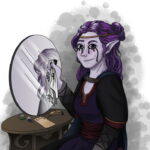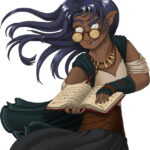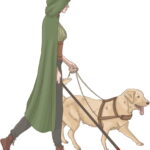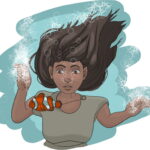Ocular Diversity
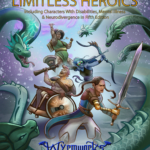
One or both of your eyes are shaped or located outside the range typical for your ancestry. Choose or roll on the following table. Note that this is usually a permanent condition and does not fluctuate, but the player and GM are welcome to determine a magical version that fluctuates based on the Frequency table above. Example stimuli include sunrise/sunset, seasons, or stress.
| d20 | Ocular Diversity |
|---|---|
| 1–3 | Location |
| 4–5 | Eyelid Difference |
| 6–8 | Bulging |
| 9–10 | Sunken |
| 11–13 | Oversized |
| 14–15 | Undersized |
| 16–19 | Pupil Difference |
| 20 | Side Placement |
Location. Each affected eye is (IE) inches from its expected location. Roll 1d12, using clock locations for direction. This gives you +(IE) to Dexterity (Sleight of Hand) checks but −(IE) to Charisma (Persuasion) checks with people who don’t know you due to many people’s discomfort around those with unexpected appearances.
Eyelid Difference. Your eyelids are an unexpected shape, such as an odd angle, or they don’t close typically, or they droop. This gives you +(IE) to Dexterity (Sleight of Hand) checks but −(IE) to Charisma (Persuasion) checks with people who don’t know you due to many people’s discomfort around those with unexpected appearances.
Bulging. Your eyes poke out of your head noticeably. This gives you +(IE) to Dexterity (Sleight of Hand) checks but −(IE) to Charisma (Persuasion) checks with people who don’t know you due to many people’s discomfort around those with unexpected appearances.
Sunken. Your eyes are sunken into your head, giving them a skull-like appearance. This gives you +(IE) to Dexterity (Sleight of Hand) checks but −(IE) to Charisma (Persuasion) checks with people who don’t know you due to many people’s discomfort around those with unexpected appearances.
Oversized. Your eyes are larger than expected for your ancestry, an extra inch diameter per IE. This gives or increases Darkvision by 10 feet × (IE) but also gives a –(IE) penalty on saving throws against being blinded by bright lights. You have −(IE) to Charisma (Persuasion) checks with people who don’t know you due to many people’s discomfort around those with unexpected appearances.
Undersized. Your eyes are smaller than expected for your ancestry by a factor of 1/2 × (IE). This gives you +1 to Dexterity (Sleight of Hand) checks but −1 to Charisma (Persuasion) checks with those who don’t know you due to many people’s discomfort around those with unexpected appearances. If you have Darkvision, this decreases it by 10 feet × (IE) but gives you a +(IE) bonus to saving throws against being blinded by bright lights.
Pupil Difference. Your pupils are horizontal (50 percent) or vertical (50 percent). Horizontal pupils decrease the normal range of a ranged weapon by 50 percent but give +1 to Wisdom (Perception) checks against those making a Dexterity (Stealth) roll against you. Vertical pupils increase the normal range of a ranged weapon by 50 percent and give advantage on Strength (Athletics) checks to jump but −1 to Wisdom (Perception) checks against those making a Dexterity (Stealth) roll against you. Those who don’t know you and see your pupil shape tend to associate it with otherworldliness or evil, so this gives you a −1 penalty on Charisma (Persuasion) checks but +1 on Charisma (Intimidation) checks.
Side Placement. Your eyes are on the sides of your skull in front of your ears. This gives you advantage on Wisdom (Perception) checks against those attempting a Dexterity (Stealth) roll against you and disadvantage on all melee attack rolls. This also gives you disadvantage on Charisma (Persuasion) checks with those who don’t know you due to many people’s discomfort around those with unexpected appearances and your inability to look others in the eye with both eyes during conversation.
Real-world Examples
Keratoconus, Blepharoptosis, Lid Retraction, Canthal Dystopias, Entropion, Ectropion, Cryptophthalmos, Coloboma, Microphthalmia
Assistive Options
Dark glasses, helmet visors, or other eye coverings can mask some of these eye differences.
Magical Assistance
The Seeming spell can alter a person’s appearance to mask this and other cosmetic eye differences.
